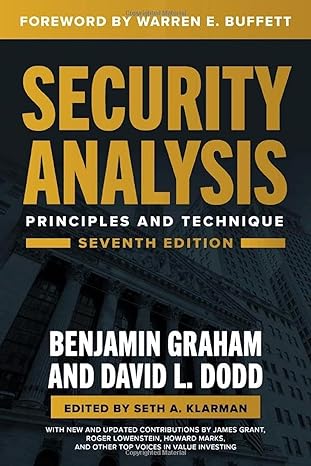Main Topic
“Security Analysis: Principles and Techniques” by Benjamin Graham is a seminal work that focuses on the principles and techniques of investment analysis and stock market valuation.
Key Ideas or Arguments
- Graham emphasizes the importance of a fundamental approach to investing, which involves a careful analysis of financial statements and a focus on intrinsic value.
- He introduces the concept of “margin of safety,” where investors seek stocks trading below their intrinsic value to reduce the risk of loss.
- The book highlights the distinction between investment and speculation, encouraging investors to adopt a long-term, value-oriented mindset.
Chapter Titles or Main Sections
- Introduction: Graham provides an overview of the principles of sound investment.
- The Scope and Limitations of Security Analysis: This chapter discusses the challenges and limitations of security analysis.
- What Is an Investment?: Graham defines the characteristics of true investments versus speculative ventures.
- General Steps in the Investment Process: The author outlines the key steps in the investment process.
- The Balance Sheet: This chapter delves into the analysis of a company’s balance sheet, a crucial component of security analysis.
- The Income Account: Graham discusses the income statement and its importance in evaluating a company’s financial health.
- Statement of Cash Flows: An exploration of the statement of cash flows and its significance.
- Fixed Value Investments: Graham provides insights into fixed-value investments like bonds.
- Stocks and Their Market Value: This chapter deals with the analysis of common stocks and market valuation.
- Stock Selection: Graham presents a comprehensive approach to stock selection.
- The Investor and Market Fluctuations: The author addresses the psychology of investors and market behavior.
- Techniques of Common Stock Investment: This section covers various techniques for investing in common stocks.
- The Enterprising Investor: Graham discusses the strategies for enterprising investors who are willing to put in more effort.
- Security Analysis for the Lay Investor: An introduction to the basics of security analysis for individual investors.
Key Takeaways
- Investors should focus on analyzing financial statements, seeking undervalued stocks with a margin of safety.
- Distinguish between investment and speculation, favoring the former for long-term success.
- The book provides comprehensive insights into various aspects of security analysis, from balance sheets to stock selection.
- Graham’s “margin of safety” concept remains a cornerstone of value investing.
Author’s Background and Qualifications
Benjamin Graham was a renowned economist, professor, and investor. He is widely regarded as the father of value investing and is known for his successful investment philosophy. His background and expertise in finance and investing lend credibility to the book.
Comparison to Other Books
“Security Analysis” is often considered the definitive work on value investing and security analysis. It stands out due to its comprehensive coverage and enduring relevance. While there are other books on the subject, Graham’s work is a foundational text that has influenced generations of investors.
Target Audience
The book is primarily intended for investors, both novice and experienced, who seek a deep understanding of fundamental analysis and value investing. It is also valuable for students and professionals in finance.
Reception or Critical Response
“Security Analysis” has received widespread acclaim for its timeless principles. It remains a classic in the field of finance and investment, with many experts considering it a must-read for anyone interested in stock market analysis.
Publisher and First Published Date
The book was first published by McGraw-Hill in 1934.
Recommendations
- “The Intelligent Investor” by Benjamin Graham.
- “Common Stocks and Uncommon Profits” by Philip Fisher.
Biggest Takeaway
“Security Analysis” teaches investors to focus on intrinsic value, seek a margin of safety, and approach investing as a long-term endeavor, ultimately aiming for sustainable success in the stock market.



